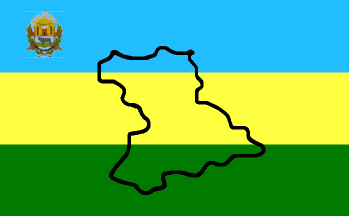 klaus-michael schneider
klaus-michael schneider
Keywords: anzoategui | venezuela | map | barcelona | phoenix bird | fortress | merlon | bull | sun | cannon | laurel | urica |
Links: FOTW homepage | search | disclaimer and copyright | write us | mirrors

Last modified: 2021-08-26 by  klaus-michael schneider
klaus-michael schneider
Keywords: anzoategui | venezuela | map | barcelona | phoenix bird | fortress | merlon | bull | sun | cannon | laurel | urica |
Links: FOTW homepage |
search |
disclaimer and copyright |
write us |
mirrors

image by Pascal Gross, 14 April 2000
See also:
Municipalities (Capitals):
The flag of the state of Anzoategui, adopted on June 16, 1999.
Source : <www.larutadelsol.com>.
Pascal Gross, 14 April 2000
Here is a translation of the information from this site:
History of the flag:
"By initiative of historian Maximilian Kopp Marcano, on
February 25th, 1999, the State governor of Anzoategui, through
the state's Direction of Culture presideded by Enrique Hidalgo,
declared open a contest through which a design for a Official
flag of the state would be found.
The contest was closed on May 19th, 1999, and on that same day
the verdict was announced. The jury, led by Judge-rector of
Anzoategui state, Zoraida Achicar de Lindo; the director of the
Estable Theatre of Barcelona, Kiddio Espana; the director of the
network of National Libraries, Anzoategui state, Cesar
Paraqueima; artist Regulo Lopez, derecitor of the Armando Reveron
School of Fine Arts of Barcelona, Antonio Sanchez; the presidents
of the Federation of Chambers of Commerce, Anzoategui, Marco
Tulio Salazar; the CHiefo of the 7th Regional Command of the
National Guard, General Carlos Bazzanella; the Secretary of the
Governor, Jose Sabino Mora; historian Oscar Parella; the state's
Director of Culture, Enrique Hidalgo, and historian Maximilian
Kopp Marcano: estudied the 152 proposals that contestants handed
in, and it was unanimously voted as winner the sketch presented
under the nom-de-plume 'Maria Isabela', by the Puerto La
Cruz-born Lemarys del valle Rincones, whon the received the award
of two million Bolivars.
The design of the state's flag, as set by decree #138 from the
regional executive signed by the state's governonr, Alexis Rosas,
has three horizontal stripes of the same width [height]. A blue
one, representing our heavens, seas and rivers. A yellow one,
standing for the warmth of our climate and people. A green one
for all the riches of our nature and, on its centre, an oputline
of Anzoategui state's map, crossing the three stripes and
embroidered in black, as a symbol of oil rich soil."
by Maximilian Kopp M. and translated by Guillermo
Aveledo, 14 April 2000
b.gif)
image from <www.larutadelsol.com>
The actual Anzoateguensian Coat of Arms was adopted by
Regional Executive Decree on September 9th, 1933. The information
about who was its designer is not available, but it is known that
the graphic composition is the same as used during the existence
of the Barcelona State between 1864 and 1881. According to the
Anzoategui State's Coat of Arms, Seal and Anthem Law in force,
published in the Official Gazette of the State on November 30th,
1976, the Coat of Arms of this Venezuelan State is divided per
fess and charges on the upper quarter in Or (yellow), a Gules
(red) fortress with four merlons of battlement and a Phoenix Bird
looking to the right side of the shield, their wings displays and
surrounded by flames at its top. At both flanques of the fortress
and vertically emplaced, appears two silvered and broken chains,
with six links each one. This symbological elements represents
the "Casa Fuerte de Barcelona" (The Fort-House of
Barcelona) where the heroically patriots of these lands battled
for the triumph of the freedom in the Independence War of
Venezuela. The Phoenix symbolizes the fatherland reborn of their
own ashes and the broken chains, the emancipation of the Spanish
yoke and the liberation of the slaves, decreed by General José
Gregorio Monagas, illustrious son of the State, when he was
President of Venezuela in 1854. The lower quarter of the Coat of
Arms shows a silvered bull stand on a natural landscape and
looking to the right of the shield on azure (blue) ground, for
represents the cattle-rising riches of this federal entity. The
cimier it's a naissant sun in Or (yellow) for represent the
geographical situation of the state: the eastern region of
Venezuela. Its rays reminds the municipalities of the Anzoa'tegui
State. The cannons crosses in saltire at the back of the shield
and jointed to a laurel crown laced by a silvered pennant with
the motto "TUMBA DE SUS TIRANOS" (Tomb of their
tyrants) symbolizes the glories obtained by the Anzoateguensians
in the Independence War of Venezuela. The motto, properly,
remains the bloody Battle of Urica which was verified in these
lands on 1814 and where died the dreadful Spanish General José
Tomás Boves who devastated a great part of the Venezuelan
patriot territories in these times. The name of this State is an
tribute to General José Antonio Anzoátegui, one of the
Venezuelan patriot heroes of the Independence War and its Capital
is the City of Barcelona.
Raul Jesus Orta Pardo, 10 August 2000